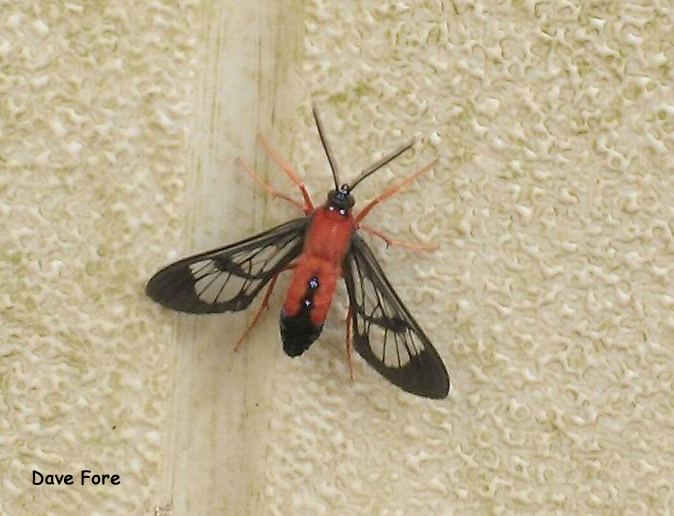Scarlet-bodied Wasp Moth, Vol. 9, No. 29
Cosmosoma myrodora
Order: Lepidoptera
Family: Erebidae
 With their clear, black-tipped wings and velvety red bodies with blue and black markings, scarlet-bodied wasp moths look almost unreal. Most of us will probably never see one of these colorful moths in the wild because they only occur in Florida and a narrow band of counties along the coast of other southeastern states, as well as parts of Mexico and Central America. People who are fortunate enough to encounter one of these moths often take pictures and try to find out what it is. Most reports from Mississippi come from the lower two tiers of counties, and, even though there are several generations per year, sightings are more common in the fall and early winter. These are mid-sized moths, with a body length of about 0.6 inches and a 1.2-inch wingspan. Thanks to Mr. Dave Fore for sharing this photo.
With their clear, black-tipped wings and velvety red bodies with blue and black markings, scarlet-bodied wasp moths look almost unreal. Most of us will probably never see one of these colorful moths in the wild because they only occur in Florida and a narrow band of counties along the coast of other southeastern states, as well as parts of Mexico and Central America. People who are fortunate enough to encounter one of these moths often take pictures and try to find out what it is. Most reports from Mississippi come from the lower two tiers of counties, and, even though there are several generations per year, sightings are more common in the fall and early winter. These are mid-sized moths, with a body length of about 0.6 inches and a 1.2-inch wingspan. Thanks to Mr. Dave Fore for sharing this photo.
These native moths not only have a restricted distribution, but their host range is restricted as well. The caterpillars only feed on climbing hempvine, Mikania scandens, a weedy, native vine that occurs through much of the eastern US. Apparently, it is winter temperatures and not host availability that keeps these moths restricted to the southernmost counties of the country.
Moths that are colorful often fly during the day and mimic wasps or have some other means of protection from birds and other predators, and this is certainly true for scarlet-bodied wasp moths. But the males have an unusual method of imparting additional protection to the females and their eggs.
Before mating male moths visit dog fennel, from which they collect toxic chemicals that they store on fine cottony fibers in special pouches on their abdomen. During mating the males dust these fibers onto the females, giving them an odor that protects them from spiders and other predators. They also pass some of these chemicals along to the eggs when mating.
Does this chemical protection really work? Cornell researchers, W.E. Conner, et. al. tested this by allowing female moths to mate with males that either had or had not been given a chance to collect dog fennel toxins and then placing them in the webs of golden silk spiders. The spiders rejected all seven of the moths that had mated with toxin-loaded males, cutting them from their web and allowing them to go free. But five of the six females that mated with toxin-free males were eaten, as were five of seven unmated females that were thrown into spider webs.
This is remarkable behavior on the part of these male moths. Dog fennel is neither a larval host nor an important nectar source for these moths. The only reason male moths visit dog fennel is to collect toxins which are used to increase the odds of survival of the females with which they mate and their resulting eggs. To learn more about these unusual moths see this article from the University of Florida.
Blake Layton, Extension Entomology Specialist, Mississippi State University Extension Service.
The information given here is for educational purposes only. Always read and follow current label directions. Specific commercial products are mentioned as examples only and reference to specific products or trade names is made with the understanding that no discrimination is intended to other products that may also be suitable and appropriately labeled.
Bug’s Eye View is now on Facebook. Join the Bug's Eye View Facebook group here.

